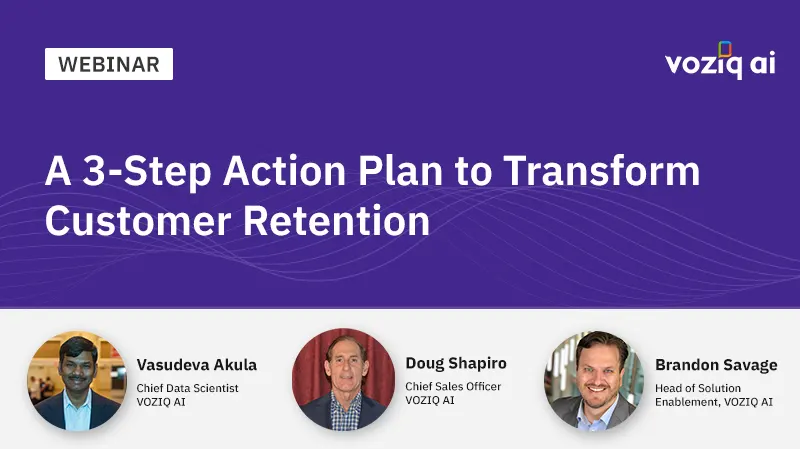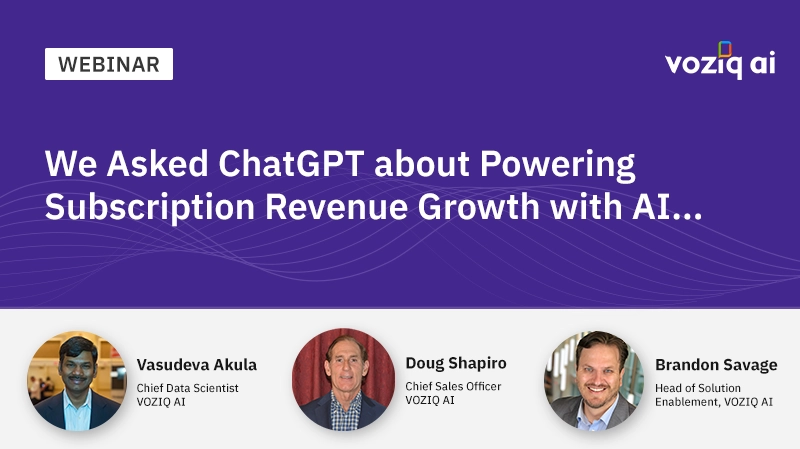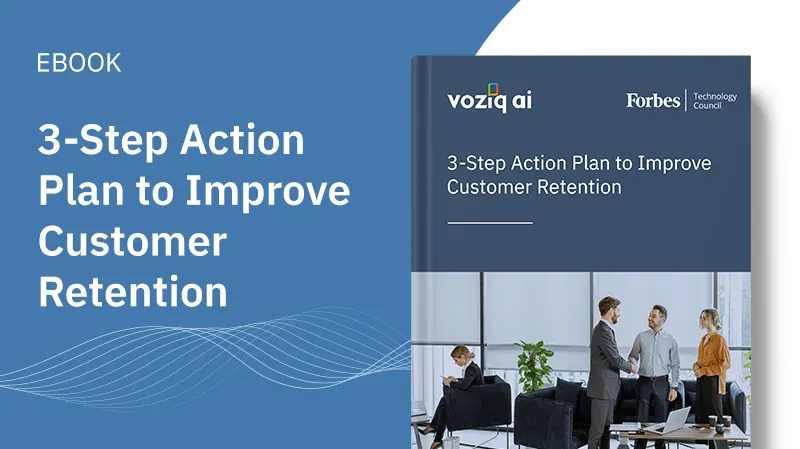A CXOs’ Guide To AI-Powered Strategies

A CXOs’ Guide To AI-Powered Strategies
In the dynamic landscape of modern subscription business, customer-centric leaders face the imperative of not only retaining customers but also driving sustainable growth.
They’re often faced with questions such as:
- How do we unveil and address churn drivers to improve customer loyalty and lifetime value?
- How do we identify at-risk customers based on the available customer data?
- How do we ensure precision targeting for proactive actions at scale?
Harnessing the transformative power of artificial intelligence (AI) can be the key differentiator in this chase. In this article, I talk about a strategic three-step action plan—a meticulously crafted AI-powered blueprint that empowers chief experience officers (CXOs) to navigate the complexities of customer retention and fuel unprecedented growth. From personalized engagement to predictive analytics, this roadmap points to a new era in which technology seamlessly aligns with human-centric strategies, reshaping the customer experience landscape.
Unlocking Success With AI: A Proven Three-Step Blueprint
This AI-powered blueprint addresses the questions listed above and guides CXOs in navigating the complex terrain of customer engagement and driving sustainable growth. Let’s delve into the intricacies of each step.
1. Strategize: Maximize The Value Of Assets With AI
The foundation of an effective AI-powered customer retention initiative lies in a well-crafted strategy. It’s crucial, as it sets the stage for the subsequent actions leading to sustained growth. Start by integrating data from various systems, including the CRM system, usage logs, customer satisfaction metrics and interactions. This comprehensive data amalgamation helps provide a holistic view of customer behavior and preferences, enabling CXOs to pinpoint areas that demand attention.
Strategizing predominantly involves leveraging data to add tangible value to customers. It helps uncover opportunities to enhance their experience, increase product or service usage and ultimately boost customer lifetime value (CLV). However, it’s critical that the data is clean and accurate.
In tandem, assess the operations of contact centers and marketing channels. Understand why customers are departing, evaluate the associated risk levels and determine actionable insights. AI-driven analytics can unravel patterns that human analysis might overlook, providing a nuanced understanding of the root causes of attrition.
2. Implement: Execute The Retention Transformation With AI
With a strategic foundation in place, the next step is to implement a retention transformation roadmap using AI. Machine learning (ML) models take center stage here, predicting churn risk and identifying risk drivers on an individual customer level. This granularity allows for the creation of risk-based microsegments, enabling tailored interventions that resonate with each customer’s unique needs and concerns.
For the frontline workforce, providing agents with contextual intelligence is paramount. Equip them with a risk-aware solution that enhances their decision-making capabilities. An intuitive platform ensures ease of use, addressing learning curve concerns and reducing potential friction in the adoption of AI-powered tools. This step not only fortifies the retention strategy but also empowers the human touchpoints within the organization to engage effectively with customers at risk.
Simultaneously, the implementation phase addresses agent bandwidth issues. Streamlining processes and eliminating unnecessary complexities help ensure that agents can focus on meaningful customer interactions rather than grappling with software intricacies. This dual focus on AI-driven insights and agent enablement lays the groundwork for a retention approach that’s not just efficient but also human-centric, fostering a synergy between technology and the human touch.
3. Scale: Increase Retention ROI Through Operational Changes.
The final phase of the blueprint begins by identifying the most relevant channels based on campaign goals and channel availability, helping ensure a strategic alignment that optimizes outreach efforts. Running economic analyses on one channel provides a foundation for embedding intelligence into multichannel offer delivery. This integration allows for a seamless and coordinated approach across diverse channels, optimizing the impact of retention campaigns. The goal is to create a unified customer experience, regardless of the channel through which engagement occurs.
Here, AI becomes a central driver for growth through additional use cases. Predictive analytics can facilitate the optimal timing and quantity of actions such as price increases, helping win back high-value customers, as well as identifying and re-engaging with leads that were previously untouched or lost, ensuring that no potential opportunity slips through the cracks. Additionally, employing predictive net promoter scores (NPS) allows you to foresee potential issues, enhance customer loyalty and generate valuable referrals.
How To Operationalize The Blueprint
Begin by involving stakeholders from various departments to collaboratively create a comprehensive business case and align the initiative with overall business goals. Simultaneously, thoroughly evaluate technological compatibility and data interoperability to seamlessly embed AI into operational workflows. Organizational alignment and training are essential components of successful implementation. Ensure the entire team is on board with the AI-driven approach and provide the necessary training to leverage these tools effectively. If in-house expertise is lacking, consider partnering with an expert to guide the implementation process, ensuring a smooth and knowledgeable transition.
You also need to set up a robust change management process, which includes clearly defined steps for implementation, monitoring and continuous improvement. By integrating change management, you can proactively address challenges, ensuring that the adoption of AI tools is embraced by the workforce.
Key considerations during operationalization include aligning AI initiatives with business goals and verifying data accuracy and relevance continually to maintain the quality of insights generated. Start with small-scale implementations, drive adoption, gather insights and then scale. This phased approach allows for adjustments based on real-world feedback, fostering a culture of continuous improvement.
The convergence of strategic thinking and cutting-edge technology is reshaping the landscape of customer experience. If you’re a customer-centric leader, this three-step approach—strategize, implement and scale—serves as a roadmap for not only retaining your customers but also driving sustained growth for your business. By systematically following this blueprint, you can ensure that your retention efforts are not only comprehensive and effective but also adaptable to the dynamic nature of the market.






